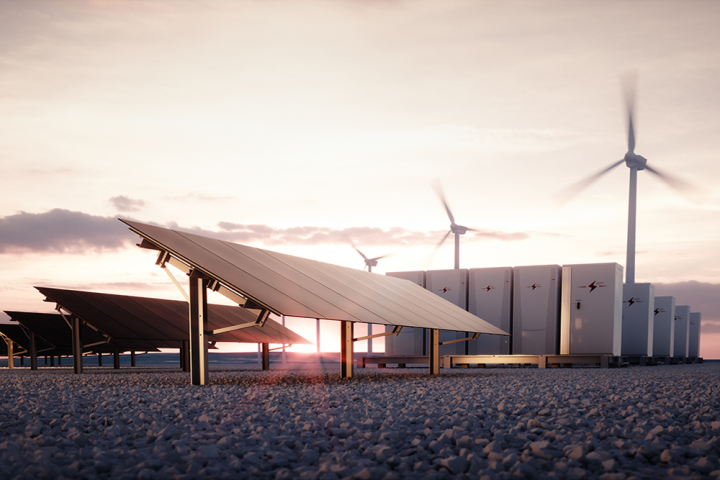
Polymers reach dizzying heights
The wind energy industry owes much of its success to composite materials. The development of epoxy or polyester resins, and foams and fibres adapted to innovative processes has made it possible to manufacture the most aerodynamically-shaped blades ever, which are also strong enough to withstand the worst of storms and are absolutely resistant to oxidation. As a result, the blades of the largest wind turbines are now more than 70 metres long and are capable of powering generators of 7 or 8 MW. There is nothing to say that this gigantism, which is increasingly criticised by bird protection groups and by those who believe that wind turbines spoil the landscape, has not reached its technical limits. However, caution is called for.

Polymer-based composite materials have made it possible to build huge wind turbine blades. This gigantism is now being challenged, especially as the first-generation blades are quite difficult to recycle.. |
Moreover, as strong as they are, wind turbines are not eternal and the first generations will reach the end of their life in a good ten years. More than 200,000 tonnes of material from the blades will have to be recycled worldwide each year. This gives us pause for thought before considering increasingly gigantic installations.
|
Recycling: plastics cook up a storm
With this in mind, Arkema has developed a new resin for bonding composite materials. Called Elium®, this particularly innovative thermoplastic resin meets environmental requirements. Its unique properties open up the possibility of recycling the products and devices that incorporate it, while offering technical characteristics similar to those of traditionally used thermosetting resins. It is particularly suited to the wind energy sector, but also to the transport and storage of hydrogen, as well as to designing boat hulls in the marine industry. According to Arkema, it requires less energy to process than thermosetting resins, which have the major drawback of not being able to be melted down for recycling. Wind turbine manufacturers are very interested in it and some, such as LM Wind Power, one of the leaders in this market, are already using it to manufacture their blades.
|
In addition to the technical performance of its newest creation, the chemist is very proud of this resin’s recyclability. Until now, wind turbine blades, created using thermosetting resins, were either crushed to be used as fuel in cement factories, for example, or buried until a way could be found to recycle them. This is not a very satisfactory solution, although some new uses have been found for them. This is the case in Ireland, where they could be a material of choice for the bridges of tomorrow. |

The new generations of blades are now recyclable. Thermoplastic resins are responsible for this achievement.. |
Arkema therefore looked into the recyclability of its resin, which can now be recycled in the traditional mechanical way. The new development is that it can now also be recycled using a chemical process.
The mechanical route is not new as it is the one used to recycle boat hulls. It involves crushing and heating the material obtained and then re-moulding it to transform it into panels with high mechanical strength. These recycled composites, which include the fibres and the resin, can be used in the building and public works sector, transport, the production of industrial equipment, etc. It should be noted, however, that the shredded hulls are only used thermally for the time being and are most often used to feed cement works.
The second type of recycling is chemical. Here again, the blades are crushed and then heated to around 400 degrees to extract a gaseous monomer. The monomer is then purified and reformulated into a resin that can be used in other applications while offering the same level of performance as the virgin resin.
Wind turbines set sail
At first, wind turbines were seen by everyone, including the general public, as the solution to global warming. This is no longer the case. Although the general public sees them as a solution for the future, they find them unsightly and no longer want to have them spoil the view. Manufacturers are therefore trying to make them more discreet. The idea of installing them at sea, far from the coast, is gaining ground. But the further away from the shore you go, the greater the depth. The only solution is to float the wind turbines rather than fix them to the underwater plateau. This is not easy because the system must remain more or less vertical and therefore must withstand the wind and waves. Although this has been achieved, it was with much smaller wind turbine models which obviously have lower energy yields.

Without plastics, it would have been almost impossible to connect floating wind turbines located several kilometres from the coast to the grid. The connecting cables must be flexible, elastic, durable and watertight... all qualities that are specific to polymers. |
Moreover, although they are located several kilometres from the coast, floating wind turbines are still influenced by the tides. This is a detail that must be taken into account when designing the underwater connection system linking the wind turbine to the electricity grid, which must be both flexible and strong enough not to break under the effect of the swell of the sea, and the ebb and flow of the tide. The copper (or aluminium) cables that carry the electricity to land are protected by several layers of different polymers, such as polyethylene and polypropylene. In the end, these connections have a diameter of about 30 centimetres and weigh 130 kg per linear metre. That's a lot of weight! The polymers are there to ensure elasticity and robustness, and above all to guarantee the watertightness of the metal cables.





